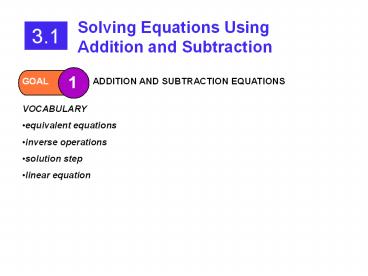VOCABULARY - PowerPoint PPT Presentation
1 / 10
Title:
VOCABULARY
Description:
Solving Equations Using Addition and Subtraction 3.1 ADDITION AND SUBTRACTION EQUATIONS 1 GOAL VOCABULARY equivalent equations inverse operations solution step – PowerPoint PPT presentation
Number of Views:33
Avg rating:3.0/5.0
Title: VOCABULARY
1
- VOCABULARY
- equivalent equations
- inverse operations
- solution step
- linear equation
2
TRANSFORMATIONS THAT PRODUCE EQUIVALENT EQUATIONS
- Add the same number to each side.
- Subtract the same number from each side.
- Simplify one or both sides.
- Interchange the sides.
3
Extra Example 1
Click to see the solution
4
Extra Example 2
Solve 11 n (2)
Click to see the solution
Solution steps are written one below the other
with the equal signs aligned.
Linear equations The variable is raised to the
first power and does not appear in a denominator,
inside a square root sign, or inside absolute
value symbols.
5
Checkpoint
Solve 5 x 3. Check your solution.
6
We will use techniques weve already learned to
write verbal models with labels, equations, and
then to solve the equations.
7
Extra Example 3
The normal high temperature in January in
Bismarck, North Dakota, is 20F and the normal
low temperature is 2F. How many degrees apart
are the normal high and low temperatures?
Click to see the solution
8
Extra Example 4
Match the real life problem with the equation. x
7 9 x 2 7 9 x 7 a. You have x
dollars and your friend repays you the 7 he owes
you. You now have 9. How much did you have
originally? b. The temperature was x F. It
fell 2F and is now 7F. What was the original
temperature? c. A 9 foot post extends x feet
below ground and 7 feet above ground. What is the
length x buried below ground?
Click to see the solution
9
Checkpoint
Your bank balance is 42. If you write a check
to buy a pair of shoes, your balance would be
5. How much do the shoes cost? Does the
equation x 42 5 model the situation? If not,
write an equation that does. Then solve the
problem to find the cost of the shoes.
No 42 x 5 47
10
QUESTIONS?































